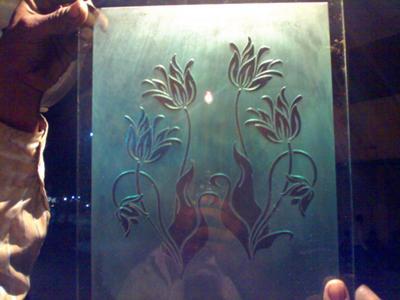Etching Glass Questions Answered
How Can I Get Screenprinted Etching Cream Even?

Silkscreened white glass
I want to know how to silk screen etching cream an even white. Generally I use abf powder with water and acetic acid mixture but mostly it remains some patches like on glass does not look similar white.
Which option i should use for etch a glass smoothly and uniformly white. Perhaps the cream will not work on large size projects like 4-5 ft or more. Harish Dewani
Milly’s reply: Thanks for your question Harish. It is very difficult to get the acid etching paste a nice uniform white, especially when you are making such large pieces of work.
Have you thought of sandblasting glass? You can get the resists made from a specialist company, or you could cut them yourself for a more unique look. Sandblasting glass is even and will read as uniformly white. It is also much less dangerous than the cream, although masks are still recommended.
Good luck with your project, it looks interesting.
What Is Etching Activator?
I’m looking into doing glass etching. I can see that some of the stencils require an “activator”. What is this, and is it toxic in any way? Trevor
Milly’s reply: Thanks for your question. It’s a bit confusing, as some of the stencils require an activator, and some don’t. It’s basically a liquid that is used to stick the re-useable etching stencils on to the glass. Some manufacturers want you to clean the glass and smear the activator on the glass before placing your stencil on top; others require you to place your stencil on the clean glass and then spray the activator over the stencil to fix it in place.
The liquid is not toxic like the etching creme is, but even so, it’s always best to be safety conscious and wear latex gloves throughout the complete acid etching process.
I hope that answers your question.
Sandblasting Information Needed
I have recently purchased a small table sandblaster and was wondering if you could help me?
Could tell me the best settings to use when sandblasting glass (wine, pint etc.) and small mirrors and also what is the best grit to use.
I just wanted to say….This is one of, if not the best glass advice site I have came across, thank you.
Milly’s reply: What lovely comments, thanks! Congratulations on getting a sandblaster – you’re going to have such fun…
Silicon carbide is the best grit to use – but as always with things glassy, it’s dangerous, so use a decent mask. The finer the grit, the smoother the etching – so that’s an aesthetic decision for you to make. If you’re doing delicate designs, go for finer grit.
It’s quite difficult to give specific advice on settings without knowing about the equipment you have and the results you require. I found a fantastic sandblasting resource on the web from a guy who is an obvious expert – Norm Dobbins. Have a look at that to get a really good overview of the basic, and not so basic. He sells books too, and might be able to answer your specific queries.
I’d also ask the people you purchased the sandblaster from for specific help.
Let me know how you get on.

